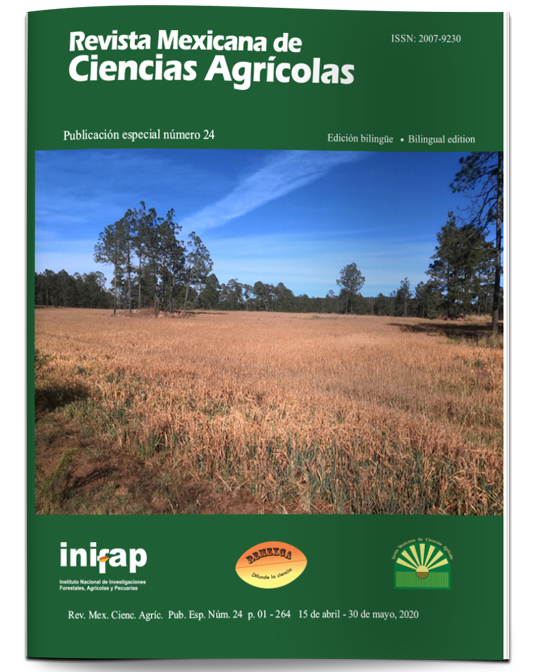Effect of PGPB bacteria, compost and digestate on the dry matter yield of cocksfood
DOI:
https://doi.org/10.29312/remexca.v0i24.2363Keywords:
Bacillus simplex, Brevibacterium frigoritolerans, Dactylis glomerata, Pseudomonas putida, forage yield andAbstract
The aim of the present study was to determine the effect of compost, digestate and PGPB (plant growth-promoting bacteria) on yield forage accumulation curve, growth rate, forage height and SPAD (soil plant analysis development) units in newly established of cocksfood under greenhouse conditions. The treatments were digestate (60%); compost (10% on dry soil based); bacteria: Brevibacterium frigoritolerans, Bacillus simplex and Pseudomonas putida; positive control (triple 17 fertilization) and negative control (soil without fertilization). A completely random experimental design was used, the experimental unit was a pot with ten tillers, with four replicates by treatment. The highest values (p< 0.05) of dry matter yield (6.4 g DM pot), growth rate (0.15 g DM pot d-1) and forage height (18.3 cm) were recorded in treatment with compost, with which the final yield was 200% higher than the negative control. The treatment with digestate showed lower values than those obtained with compost but surpassed the rest of the treatments. The best PGPB were Pseudomonas putida and Bacillus simplex, which outperformed Brevibacterium frigoritolerans and negative control by 25 and 37%, respectively. The PGPB bacteria can be a fertilization alternative since the yield was higher than with the negative control and was equal to the yield with chemical fertilization; however, the two organic fertilizers (compost and digestate) favored the higher yield.
Downloads
Downloads
Published
How to Cite
Issue
Section
License
The authors who publish in Revista Mexicana de Ciencias Agrícolas accept the following conditions:
In accordance with copyright laws, Revista Mexicana de Ciencias Agrícolas recognizes and respects the authors’ moral right and ownership of property rights which will be transferred to the journal for dissemination in open access. Invariably, all the authors have to sign a letter of transfer of property rights and of originality of the article to Instituto Nacional de Investigaciones Forestales, Agrícolas y Pecuarias (INIFAP) [National Institute of Forestry, Agricultural and Livestock Research]. The author(s) must pay a fee for the reception of articles before proceeding to editorial review.
All the texts published by Revista Mexicana de Ciencias Agrícolas —with no exception— are distributed under a Creative Commons License Attribution-NonCommercial 4.0 International (CC BY-NC 4.0), which allows third parties to use the publication as long as the work’s authorship and its first publication in this journal are mentioned.
The author(s) can enter into independent and additional contractual agreements for the nonexclusive distribution of the version of the article published in Revista Mexicana de Ciencias Agrícolas (for example include it into an institutional repository or publish it in a book) as long as it is clearly and explicitly indicated that the work was published for the first time in Revista Mexicana de Ciencias Agrícolas.
For all the above, the authors shall send the Letter-transfer of Property Rights for the first publication duly filled in and signed by the author(s). This form must be sent as a PDF file to: revista_atm@yahoo.com.mx; cienciasagricola@inifap.gob.mx; remexca2017@gmail.
This work is licensed under a Creative Commons Attribution-Noncommercial 4.0 International license.



